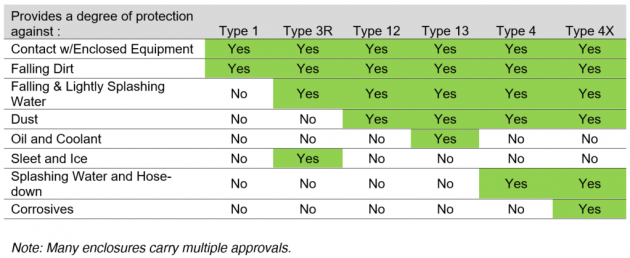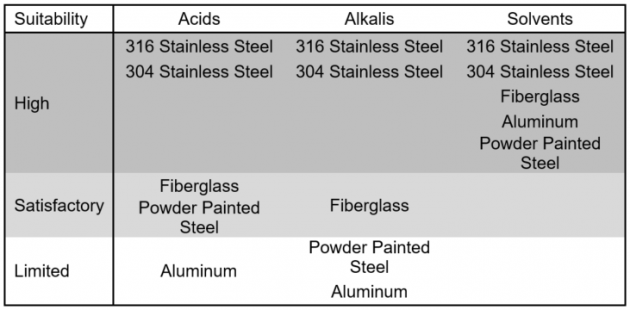
While the electrical and electronic devices required in the assembly of a control panel are the focus of your design efforts, underestimating or delaying the selection of an appropriate enclosure might cause significant issues which can be avoided with just a bit of forethought. Consider these key factors in advance and save yourself headaches.
Which Electrical Enclosure Should I Use?
A quick Google search for “electrical enclosures” returns 58 million results so it is not surprising that some specifiers may feel a bit overwhelmed at the task. For most applications, there is a perfectly acceptable solution readily available – in fact Hammond Manufacturing alone has over 6,000 standard electrical enclosures and accessories. Reaching out to an enclosure supplier for support when needed is ideal, but you will need to know some critical information to decide what’s appropriate.
There are many factors that can affect the selection of an enclosure for a particular application. We will focus on seven common considerations for Electrical Enclosures:
1. Protection Rating
2. Certifications and Approvals
3. Size
4. Access Needs
5. Cost
6. Temperature Environment
7. Corrosion Resistance.
Protection Rating
An enclosure’s protection rating indicates the degree of protection that the enclosure provides for the equipment that is inside. Enclosures are rated according to their ability to prevent various levels of dirt and liquids from entering. These protection levels are commonly referred to as “Type” or “NEMA” (National Electrical Manufacturers Association) ratings.
The table shown here outlines the “Type”/”NEMA” ratings and protection levels for Hammond Enclosures.

This table outlines the “Type”/”NEMA” ratings and protection levels for Hammond Enclosures.
Certifications and Approvals
Standards organizations create rating measurements for the performance of different products. Electrical enclosures categories are defined by organizations like NEMA, CSA, UL, and IEC to identify an enclosure’s ability to provide protection from dust, dripping water, hose directed water, and more.
While these standards are all intended to guide the user to make the right choice of product, there are some important differences between them.
In North America, NEMA, UL, and CSA are the most commonly recognized standards organizations. They are almost identical in their rating and testing of enclosures.
Want to see other articles on Automation? Click here to download our new Automation Handbook.
UL and CSA require that enclosures be tested in an approved lab in order to prove their performance. They regularly inspect manufacturers to ensure they use the approved materials and construct to previously tested product designs. In turn, they provide “certification labels” to be permanently attached inside the enclosures.
While NEMA ratings are a common reference, distinct from UL/CSA, that organization does not provide testing services, they leave compliance and testing to the discretion of the manufacturer, and they do not provide “certification labels” for enclosures.
In Europe, IEC ratings are the most commonly recognized standards for enclosures. IEC ratings are similar to NEMA, but the pass or fail requirements are different. IEC primarily focuses on ingress protection and does not include distinct ratings for enclosures in conditions of corrosion, rust, oil, ice, or explosive (hazardous) environments.
IEC does not provide testing, so testing and compliance is left up to the manufacturer. In Europe, TUV and VDE are two popular, testing agencies that manufacturers sometimes use to validate protection levels.
Size
Kind of basic, but consider the minimum dimensions of the enclosure needed to house all of the installed components – e.g. how deep is the deepest component? Then, confirm if there are physical size limitations in the area where the enclosure is to be installed – is the space available wide open, short and wide, tall and thin, etc.
Hammond has over 600 sizes of standard enclosures available from inventory to meet almost every size of application. While sometimes necessary, specifiers that request a custom size will likely limit their supplier options, increase costs, and lengthen lead times.
Access
The interior of an enclosure is accessed generally through a front door/cover. These can be closed with quarter turn latches, clamps, handles, or screws. The proper choice will be driven by frequency of access, security concerns, and planned device mounting on the door (e.g. handles take up more door space).
Larger enclosures can offer expanded access options with optional door on the rear or removable side panels. When security is an issue, often basic accessories additions can include padlock hasps, tamper proof screws, or key lockable hardware.
Cost
While choosing the proper protection level is key, there are some ways to save costs.
Do not over-specify the protection level. For example, a clean commercial environment generally only needs a Type 1 level of protection and specifying Type 12 industrial protection will just add cost. Similarly, specifying Type 316 stainless steel when Type 304 stainless steel is appropriate will unnecessarily raise the price.
In general, designing custom enclosures from scratch will drive costs up. Use of standard enclosures or modified standard enclosures allows manufacturers to use their existing hardware, processes and approvals to meet most of your needs.
Temperature
It is important to consider where the enclosure will be installed as the ambient temperature can definitely impact the performance of the equipment enclosed within a cabinet. You should be aware of the minimum and maximum ambient temperature along with equipment temperature tolerances.

This guide is for the use of various materials in different types of corrosive environments
In a very warm environment, it may be necessary to compensate by using a larger enclosure. This would allow more air to circulate around the components in the enclosure and provide a larger surface area on the enclosure to dissipate heat. Another option is to use some form of supplementary cooling apparatus, like cooling fans, heat exchangers, or an air conditioner, designed for this purpose.
In colder climates, heating is often needed to maintain a minimum temperature. There are numerous heating solutions available for small to large enclosures. In humid environments, heaters can also help control condensation issues by keeping enclosure temperatures above the dew point.
Corrosion Resistance
Enclosures are used in many different environments, some of which are very corrosive. Enclosure manufacturers use materials such as Stainless Steel (304 and 316L), Aluminum, Polycarbonate and Fiberglass Reinforced Polyester to help combat these environments.
The popular Type 4X standard is widely known for “corrosion resistance”, but it’s important to realize that achieving this approval is based solely on resistance to certain concentrations of salt. If there are other corrosive chemicals in the environment, the standard Type 4X materials can have widely different levels of performance.
In Closing
The performance of a control cabinet can be significantly impacted by poor enclosure selection. Use the considerations above to choose wisely and reach out to an enclosure expert with any concerns you have. This guide is for the use of various materials in different types of corrosive environments. For more information on enclosure selection, please speak to your local Hammond Manufacturing distributor, sales representative or contact factory support here.
The website www.hammondmfg.com is well structured and advanced search functions to find the proper enclosure you need.
About the author: Sheldon Butts is the National Sales & Marketing Manager for the Electrical Enclosure Division of Hammond Manufacturing in Canada.
Print this page